Selected Current Research Projects
Reducing Energy Barriers for Novel Water Supply Use in Sustainable Agriculture
Sponsored by the National Science Foundation
Dr. Leibowicz and colleagues received a $3 million grant to establish an NSF Research Traineeship (NRT) on food-energy-water systems (FEWS) at UT Austin. Drought, overuse of water resources, deteriorating water quality, and climate variability are contributing to increasingly frequent and sometimes permanent water shortages for agriculture. This is a major concern because irrigated farms contribute to approximately half of U.S. crop sales, greater crop yields, reduced poverty, affordable food, and positive health and nutrition outcomes. Water conservation alone is not enough. Unconventional water resources must be utilized, but the overwhelming barrier is energy cost. The energy sector is undergoing a significant transformation due to the expansion of wind and solar energy. There is an opportunity to use increasingly abundant and cost-competitive renewable energy to provide inexpensive and plentiful water for water-stressed agricultural lands. This NRT is training a new generation of students to design transformative and globally relevant solutions to develop unconventional water resources for agriculture by harnessing renewable energy and recovering energy-containing resources from wastewater. In addition to research, trainees benefit from dedicated NRT courses, a FEWS seminar, dual-faculty and alumni mentoring, internships, career development activities, and local public service. The project intends to train a diverse cohort of 36 M.S. and Ph.D. students, including 18 funded trainees, from engineering, public affairs, and geosciences.
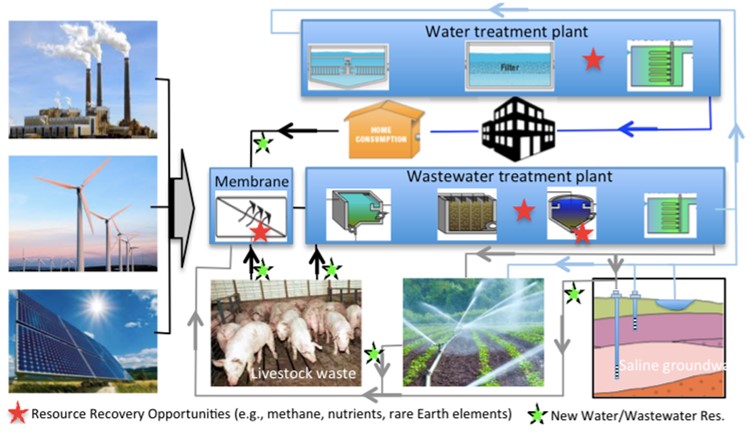
The Economics of Scaling Carbon Capture, Utilization, and Storage
Sponsored by the Alfred P. Sloan Foundation
Dr. Leibowicz, colleagues from UT’s Lyndon B. Johnson School of Public Affairs, and collaborators at the University of Wyoming were awarded a grant from the Alfred P. Sloan Foundation to study the economics of scaling carbon capture, utilization, and storage (CCUS). Most scenarios for cost-effective, deep decarbonization of the U.S. economy envision CCUS playing a key role due to the diversity of its potential applications, such as power plants, industrial facilities, and hydrogen production. However, despite the technological readiness of CCUS and bipartisan support for it in government, CCUS deployment has been slow to scale up. This project will use operations research and economics to assess the barriers to large-scale deployment of CCUS and investigate policy approaches for overcoming them. In addition to the research carried out by Dr. Leibowicz and the rest of the team, they will issue a request for proposals and award seed grants to researchers at other institutions to build a research community around CCUS. The project will culminate in a final workshop at UT that brings together the project team, seed grant recipients, other academic experts, and leaders from government and industry.

Economic Impacts of Disruptions to Interconnected Infrastructure Systems
Sponsored by the Defense Threat Reduction Agency (via University of Southern California)
Disruptions such as extreme weather events and deliberate attacks can cause widespread damage to critical infrastructure systems including networks for power, water, natural gas, transportation, and communications. Since these infrastructures depend on one another, cascading failures within and across infrastructure systems can amplify the direct impact of a disruption and leave many customers without access to critical services. In this project, Dr. Leibowicz and his team at UT Austin are collaborating with the University of Southern California, University of Pittsburgh, Victoria University (Australia), and Leidos to develop mathematical models and software tools to estimate the economic impacts of disruptions to interconnected infrastructure systems. They are modeling the post-disruption operations of the infrastructures and the service restoration process to ultimately calculate the magnitude (how many customers) and duration (for how long) of the service interruption for each infrastructure. These outputs of UT’s modeling will serve as inputs to a computable general equilibrium model of the regional economy, which computes the economic impacts of the infrastructure service interruptions as they ripple across different economic sectors.

Sampling Design for Random Inspections
Sponsored by the Department of Homeland Security (via Texas A&M University)
The Department of Homeland Security (DHS) and United States Department of Agriculture (USDA) implement the Agriculture Quarantine Inspection (AQI) program, which aims to mitigate the pest threat to U.S. agriculture by inspecting people and cargo at U.S. ports of entry. In this project, Dr. Leibowicz and Dr. John Hasenbein are working with the Cross-Border Threat Screening and Supply Chain Defense center at Texas A&M to help DHS and USDA turn AQI into a more data-driven program. They are assessing the random sampling protocols that the program currently uses to estimate the probabilities of pest importations via various pathways. The project is also modeling alternative sampling protocols to explore whether they could achieve superior results using the available resources.
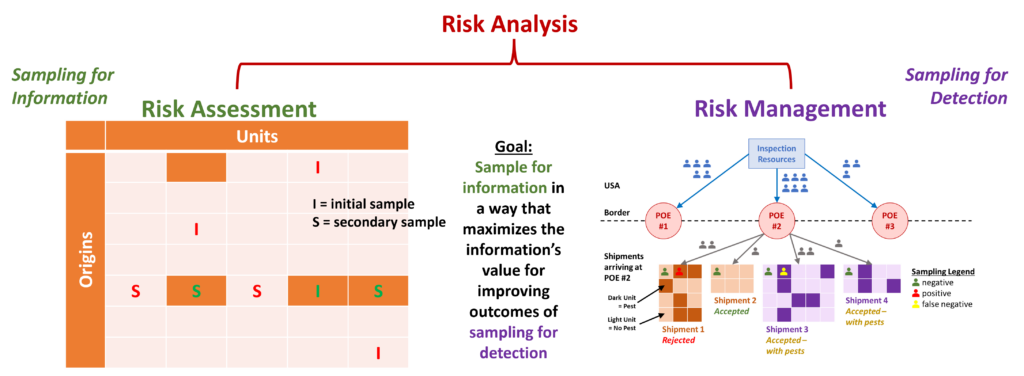
Project Portfolio Optimization with Fixed Production Profiles
Sponsored by ExxonMobil Upstream Research Company
In this project, Dr. Leibowicz and colleagues are developing optimization models and algorithms to help a company invest in production, collection, and processing facilities across a spatial infrastructure network. In particular, they are focusing on problems where investing in a production facility results in a fixed production profile over time, but where the production profile is uncertain at the time of the investment decision. In general, this class of problems leads to stochastic mixed-integer programs that make it challenging to determine optimal investment portfolios. Case studies of this type of problem abound in industries such as oil and gas, electricity, and mining.
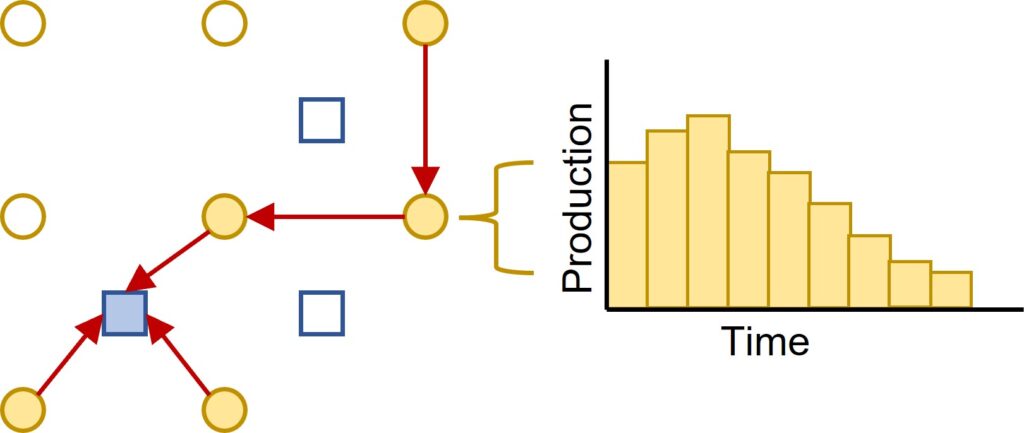
Smart Charging (and Discharging) of BEVs for Lower Grid Emissions and Better Grid Performance
Sponsored by the UT Energy Institute
The impact of battery electric vehicles (BEVs) on electricity costs and emissions will depend critically on when they elect to charge. If they charge when electricity demand is low and renewable generation is high, then BEVs could absorb low-cost, clean power. As a potential added benefit, vehicle-to-grid functionality could allow BEVs to supply power to the grid at times when it is stressed. However, if these vehicles charge when demand is high and renewable generation is low, then they could require high-cost, emissions-intensive fossil fuel power plants to run, and also create a need for greater investment in generation and storage capacity. In this project, Dr. Leibowicz and colleagues are exploring the costs and benefits of electric utility programs that incentivize BEV owners to charge (and possibly also discharge) their vehicles at times that benefit the electric grid. To do so, they are administering a survey to estimate how much customers would need to be paid to cede control of BEV charging to the utility, while employing an electricity capacity expansion model to estimate the benefits of utility control over BEV charging schedules.
Selected Previous Research Projects
Energy Market Dynamic Modeling
Sponsored by ExxonMobil Upstream Research Company
Decisions about where and when to open new natural gas projects, and how to assign flows in the network, rely on a deep understanding of natural gas commodity market dynamics. The market is constantly evolving due to technological trends like the shale gas revolution, shifting regulatory landscapes, geopolitical events, financial developments, and macroeconomic factors that affect demand. The natural gas market involves a wide variety of strategic players including producers, traders, storage operators, pipeline operators, and consumers. Their complex interactions are often represented using equilibrium models formulated as mixed complementarity problems. In this project, Dr. Leibowicz and colleagues are advancing the modeling state of the art by incorporating richer sets of endogenous decisions and market drivers, with the goal of improving model realism and applicability to corporate decision making. The focus is on the U.S. natural gas market in the medium-term.

Decentralized Investment and Operation of Distributed Energy Resources in a Capacity Expansion Model
Sponsored by Lawrence Berkeley National Laboratory
Models that optimize generation and transmission expansion decisions in the electricity sector traditionally adopt the perspective of a single decision maker who simultaneously chooses all capacity investments and dispatch schedules throughout the entire system. As customers increasingly adopt distributed energy and storage technologies, this traditional modeling paradigm is becoming inadequate. In this project, Dr. Leibowicz and his team are collaborating with researchers from the Electricity Markets and Policy Group at Lawrence Berkeley National Laboratory to represent the interactions between centralized and decentralized investment and operation decisions in a capacity expansion model. The methods developed in this work will help utilities optimize generation and transmission investments while anticipating the effects of these decisions on distributed energy and storage adoption throughout the network.

Strategies for Mitigating Climate Impacts of Gulf Coast Industrial Facilities
Sponsored by The Cynthia and George Mitchell Foundation
The abundant and affordable energy made available by growing oil and gas production in Texas and neighboring states is attracting new industrial facilities to the Gulf Coast region. Over the coming years, new oil refineries, natural gas liquefaction and export terminals, gas-fired power plants, petrochemical manufacturing plants, and other large industrial facilities are expected to be brought online. In this project, Dr. Leibowicz and colleagues from the Lyndon B. Johnson School of Public Affairs are developing a detailed inventory of new industrial facilities associated with the oil and gas sector in the Gulf Coast region, and estimating their impacts on greenhouse gas and air pollutant emissions. They will then evaluate the potential and cost-effectiveness of alternative technology and policy approaches for mitigating these environmental impacts.
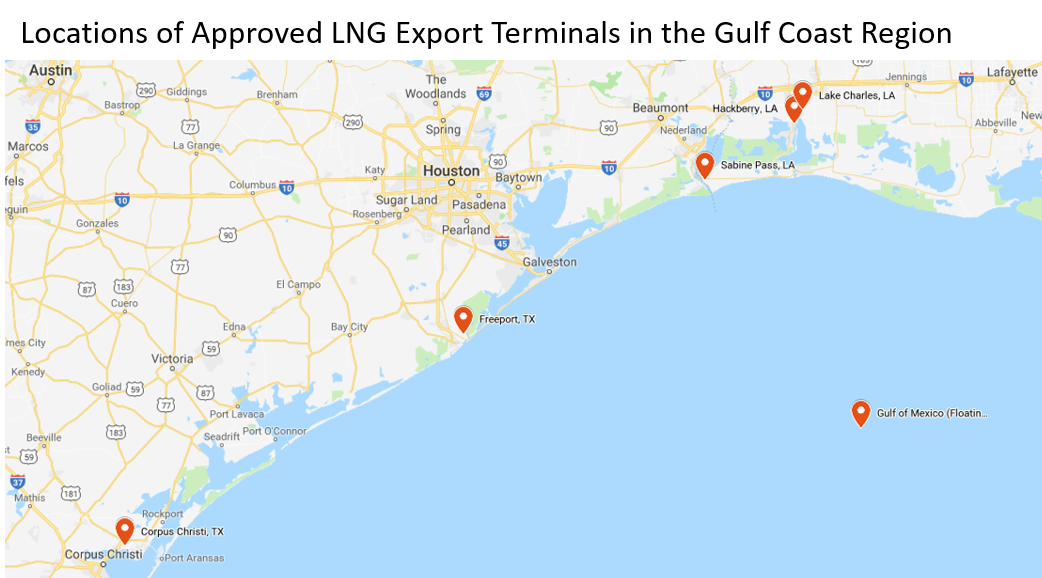
Designing Electric Vehicle Charging Infrastructure to Enable Disaster Evacuation
Sponsored by the UT Department of Mechanical Engineering Seed Grant Program
At present, the threat of power outages is not a major obstacle for evacuations because cars are overwhelmingly fueled by gasoline. However, as electric vehicles (EVs) are projected to account for half of all light-duty vehicle sales by 2035, evacuations ahead of impending disasters will soon need to rely on expansive and robust EV charging infrastructure networks. This infrastructure not only includes the charging points, but also the electric infrastructure components required to keep power flowing to them: power plants, transmission and distribution lines, and distributed energy resources (DERs) such as on-site diesel generators, solar panels, and battery storage. The goal of this project is to develop an optimization toolkit for EV charging network design and electric infrastructure resilience investments to enable disaster evacuations with high EV penetration. As shown below, the approach considers the spatial interdependence between overlapping electric and road infrastructures to optimally enhance their mutual resilience. The modeling paradigm is a two-stage stochastic program with infrastructure investments in the first stage, uncertainty represented through disaster scenarios, and then an energy-limited traffic assignment problem (ELTAP) with routing of evacuating EVs in the second stage.
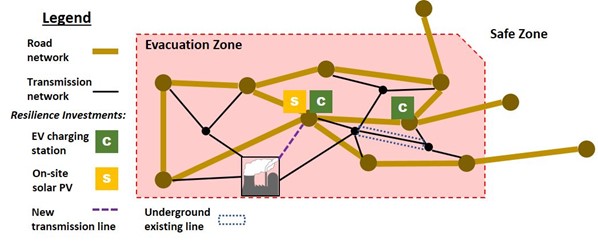
Sectoral Feasibility of Greenhouse Gas Mitigation and Clean Energy Transitions
Sponsored by the UT Energy Institute
In recent years, there has been renewed interest in sector-specific technology and policy strategies for reducing GHG emissions. While the power sector decarbonizes with the expansion of renewables, in other major sectors of the economy such as transportation and industry, mitigation progress has been much slower. Different sectors of the economy face unique techno-economic and political/organizational obstacles to decarbonization. Transitioning a given sector to low GHG emissions might be feasible from a techno-economic point of view, but be extremely difficult from a political/organizational standpoint, or vice versa. Furthermore, the techno-economic and political/organizational feasibility of decarbonizing a particular sector could vary considerably across countries. In this highly interdisciplinary study, Dr. Leibowicz and his team are collaborating with UT researchers from the Lyndon B. Johnson School of Public Affairs and the School of Law to compare the feasibility of decarbonizing different sectors of the economy in the U.S., China, and India. This study is unique in that it considers both the techno-economic and political/organizational dimensions of energy transitions, and applies a systematic approach to comparatively analyze the world’s three largest GHG emitters.

Modeling the Nuclear Fuel Production Process
Sponsored by Los Alamos National Laboratory
The Department of Energy is planning to construct the Versatile Test Reactor at Idaho National Laboratory to reinvigorate U.S. research on advanced nuclear fuels, materials, instrumentation, and sensors. In order to operate, this reactor would require a new production facility and process for U-Pu-Zr metal alloy fuel pins. Dr. Leibowicz and his team are collaborating with researchers from the Nuclear and Radiation Engineering (NRE) program at UT and from Los Alamos National Laboratory to evaluate alternative design configurations for the fuel pin fabrication process. Successful designs will produce a sufficient quantity of fuel pins with high probability, be compatible with space constraints of existing buildings, achieve high efficiency and low cost, and reduce employee radiation exposure as much as possible. This last consideration makes this application different from most traditional manufacturing systems problems, leading to this unique and interdisciplinary collaboration between the ORIE and NRE programs.

Energy Infrastructure of the Future
Sponsored by the UT Energy Institute
The world is undergoing a variety of energy transitions as a result of demographic, economic, climatic, technological, and social forces that are changing how we acquire and use energy. These transitions will result in trillions of dollars of infrastructure investment by 2050. However, it is currently unclear what infrastructure will be needed in the coming years, and how different transitions will impact public and private stakeholders. This work intends to inform energy infrastructure investments by creating decision support tools and providing an extensive look at how future energy services will be provided and energy resources produced, moved, and consumed throughout the U.S. As part of this larger project, Dr. Leibowicz is developing a multi-regional energy system optimization model for the U.S. that identifies the most cost-effective transition pathway through 2050, subject to economic, technological, and policy assumptions. This model integrates a variety of energy supply and demand sectors in a unified framework, and optimizes the spatial development of energy infrastructure networks including electric transmission and natural gas pipelines.

Measuring the Economic Impacts of Extreme Events on the Power Sector
Sponsored by Lawrence Berkeley National Laboratory
There is widespread concern among policymakers, the electric power industry, customers, and other stakeholders that power outages due to extreme events are becoming increasingly frequent and severe. Changing weather patterns and the potential for deliberate physical and cyberattacks on the power system mean that many utilities are considering costly investments to harden infrastructure and improve resilience. However, making informed decisions about such investments requires estimating the economic impacts of large-scale, long-duration power interruptions, so that the benefits of mitigating these risks can be compared against the costs of countermeasures. In this project, Dr. Leibowicz and his team are collaborating with researchers from the Electricity Markets and Policy Group at Lawrence Berkeley National Laboratory to review the available information on estimated economic impacts of historical extreme events on the power sector. They are identifying gaps in available estimates and cataloging the methodologies that are employed to calculate them. The project will focus on six detailed case studies of electric utilities that have confronted extreme events in California, Florida, New Hampshire, New York, Texas, and Washington.

Markov Models of Policy Support for Technology Transitions
Governments often have an interest in promoting the development and diffusion of new technologies in domains like clean energy, transportation, healthcare, and agriculture. However, designing a portfolio of policies to effectively stimulate a technology transition is extremely challenging. Innovation processes are highly uncertain, and even when a promising new technology emerges, it typically faces an uphill battle to overcome lock-in effects that favor the persistence of the status quo. In this project, Dr. Leibowicz and his team are developing a series of Markov models to theoretically investigate the problem of a policymaker seeking to optimally support a technology transition, considering both costs and benefits. These models yield generalizable insights. For example, they shed light on the proper balance between early-stage and late-stage policy support, and how this depends on key properties of the innovation and diffusion processes in question.

Analysis of Urban-Scale Climate Change Mitigation Strategies
Cities account for 75% of global energy use and carbon emissions, and in the last several years, cities have begun asserting themselves as important climate policy actors. The C40 Cities Climate Leadership Group of urban areas committed to achieving the goals of the Paris Agreement has grown to include 96 cities that are home to one in 12 people worldwide, and encompass 25% of global GDP. While cities have major aspirations for climate change mitigation, they often must rely on non-traditional mitigation strategies that fall under municipal jurisdiction and can be implemented at the urban scale. In a series of projects, Dr. Leibowicz is modeling the effects of such strategies within complex urban settings in order to guide policy formulation and avoid unintended environmental or economic consequences. One branch of this work is theoretical, based on spatial equilibrium modeling of urban areas that captures the mutual interdependence of urban form and energy consumption. A second branch of this research is computational, and uses detailed energy system modeling tools to evaluate the cost-effectiveness of alternative urban-scale decarbonization strategies.

